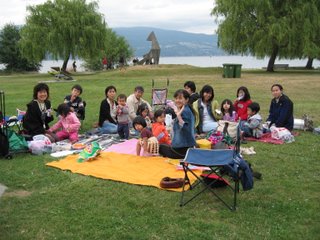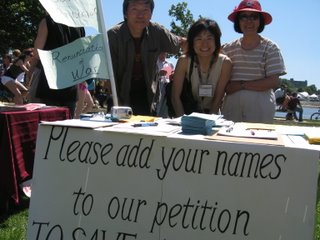This poem just came up in my mind in ten minutes or so, and I wasn'tsure about sharing it. I emailed it to Helen Lim, my best friend who was a lawyer in China. Helen was my roommate in the high school dormitory who had great talents in all sorts of arts - music, literature,and poetry. She checked my English and suggested some improvements, just as she used to do twenty years before, and assured me that this poem was worth sharing with others.
As I read the poem at the party, I saw tears not only in the eyes of Ms.Palamarek but also in those of other parents'. It was the first time in my life that I saw my words move people in the way it did that evening. Although I was somewhat embarrassed, I was happy that I took courage to read the poem.
Since then I have shared this poem with a couple of friends (who were teachers) that were special to me. Tonight, on the last day of the year in which Japan said a farewell to the 1947 Fundamental Law of Education which upheld education free from state control and freedom of individual minds, I would like to dedicate this poem to all teachers of Japan, and all teachers of the world.
~~~~~~~~~~~~~~~~~~~~~~~~~~~~~~~~~~~~~~~~~~~~~~~~~~~~~~~~~~~~~~~~~~
Kotoba
I thought hard for words
To express my appreciation to a teacher
Then I thought about the word 'word' itself
And what it carries and means in my mother tongue
Kotoba means “word” in Japanese
Koto is 'to say' and ba is 'leaves'
I wondered why and how 'leaves' are part of this magical word
The word that means 'word'
This is what I thought:
Words of a teacher are like leaves
Leaves nurture the tree while on the tree
And even after they fall off
Leaves nourish the soil so that the tree will grow taller and stronger
The power of the leaves stay within the tree,
Sprouting in endless cycle
Forever and ever
Words of a teacher are like leaves
Words of a teacher nurture children when they are under her care
And even after the children leave her classroom
Her words nourish the souls of these children
So that their souls grow richer, and stay within
Budding into new talents and actions
Forever and ever
So this is my kotoba to you
Thank you for your nourishing kotoba to my child
Kotoba of encouragement
Kotoba of knowledge
Kotoba of discipline
Kotoba of love
And other kotoba which fall from your lips into the spirit of my child
Your kotoba will stay within the soul of my child
In endless cycle
Forever and ever
~~~~~~~~~~~~~~~~~~~~~~~~~~~~~~~~~~~~~~~~~~~~~~~~~~~~~~~~~~~~~
Nothing can come between the honest and sincere exchange of kotoba between teachers and children, and nothing can hinder the nourishment of free souls by genuine and loving guidance of teachers. When teachers are free, children are free. When children are free, the world is free.
With love and hope for the year that will start tomorrow,
Satoko










 The Asia Regional Conference
The Asia Regional Conference 


 I was in Maui from November 16 to 20th, 2006 to attend a workshop called 'Self-Identity Ho'oponopono,' founded by MORRNAH NĀLAMAKŪ SIMEONA (1913 - 1992) and taught by Dr. IHALEAKALĀ HEW LEN. I wanted to find some answers for my quest for peace within myself, my family and the world.
I was in Maui from November 16 to 20th, 2006 to attend a workshop called 'Self-Identity Ho'oponopono,' founded by MORRNAH NĀLAMAKŪ SIMEONA (1913 - 1992) and taught by Dr. IHALEAKALĀ HEW LEN. I wanted to find some answers for my quest for peace within myself, my family and the world.
